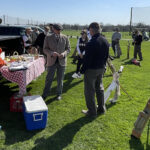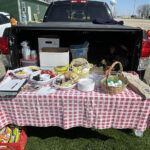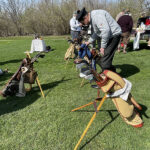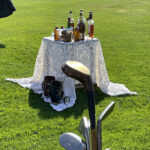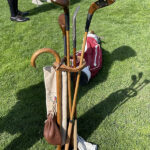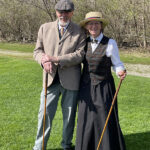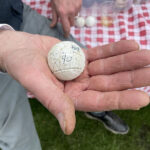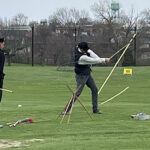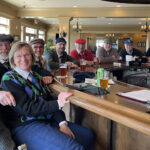April 19, 2022
By MacDuff
Since the advent in 2000, and even earlier, of modern hickory golf the sport has followed many paths, blossomed in a variety of forms. Hickory tournaments large and small, from gutty to golden-era 1920s style of play, offer opportunities to “discover the playing characteristics of wood shafted golf clubs,” as the Society of Hickory Golfer’s mission statement says.
The current availability of replica clubs allows players a quick entry into the hickory community. Building a set of original clubs is a longer term approach, with players studying the early makers, trying their own hands-on club maintenance and, for a few philosophers, the deep dive into making slender, beautiful long nose clubs that pay homage to the clubmakers’ art of the early to middle-late 1800s.
Dave Brown, of McIntyre Golf, has been making replica gutty balls for many years. It was inevitable that some would try their hand a feather balls. Most hickory golfers are familiar with the golf balls of the early 1800s, made by stuffing brine-soaked goose down into a small leather pouch, stitching the seams and waiting some little while for the feathers inside to dry, forming a hard, compact ball.
In early April, your correspondent and two others from Grand Rapids, Mich., drove to Washington, Ill., near Peoria, to discover the playing characteristics of feather balls and period-appropriate woods. The opportunity is made possible by Denny and Cathy Lane of East Peoria who are intrigued by the early history of golf and for the past several years have become adept at the art of crafting handmade feather balls. (They were featured in the Spring 2020 edition of A Wee Nip in The Golf journal of the Golf Heritage Society.)
Thus it was that some two dozen like-minded souls gathered on a very cool but sunny morning at the Hillcrest Golf Center in Washington, Ill: getting acquainted, greeting friends and nervous newcomers; the photographs, the comparing of various clubs.
The Lanes laid on a handsome breakfast of fruit, jams and shortbread baked by Cathy, everything spread on the tailgate of Denny’s pickup truck backed up to a practice green near the far end of the parking lot.
A basket near the comestibles held what at first appeared to be Easter eggs, but which were in fact feathery golf balls, each marked “LANE.” Sold normally for $30 each, they were gifts for participants to use for the feather ball round following the nine-holes of gutta ball play. Period clubs available for loan, as needed.
Before that could happen, the Lanes called us all together for a toast to the day, to each other, and to the sport. Your choice of some half-dozen varieties of bourbon or whisky.
Gutty golf is itself a very different animal, using smooth-faced irons, a few woods, perhaps, with replica balls made by Mr. Brown of McIntyre Golf. The click of those balls is something Harry Vardon would have known well. It was the “sound of golf” for many years, he said.
Following nine holes of gutty golf, the players warmed and restored themselves in the clubhouse with a lunch of Scottish soups made by Cathy from recipes she researched online. The cock a leekie soup was the best I’ve ever had.
All right, to the featheries.
Denny, who works part-time on the Hillcrest grounds crew, fashioned six small greens, more or less oval, roughly a yard and a half by two to three yards long, near the modern greens on the back nine; rough surfaces that might be about 3 on the Stimpmeter, Denny estimates.
Horace Hutchinson wrote that a good feather ball player was cracking along if he got in a drive of 160 yards. I saw some that may have approached 100, but most were in the 60- to 80-yard range.
The balls held up very well, a sort of “thup” when hit, not a click. Early Lane featheries were often given to exploding, but the couple’s constant experimentation with leather grades, stitching technique and other particulars has led to a very workable ball. Denny displayed one he had “hit the heck out of” in his basement driving net. It had a “90” written on it, the number of blows it had survived. It was a bit soft, but sturdy enough for him play on this day. Another 12 holes, another 60 shots or so and still in one piece, though admittedly a little the worse for wear.
By our estimate, we were the only people on the entire globe playing with feather golf balls at the time; a proud and exclusive tribe. What those very early players must have experienced?, the rough courses they traversed, and those early clubs? Thanks to the Lanes, we could at least approximate that time.
Your correspondent, with a borrowed long nose replica, began to try the long, swooping St Andrews swing and found it answered very well as long as no press was involved. What a treat to thump out an 80-yard corker, then try a lofter before sending a rough putt trundling toward a crude hole. No sweet-talking a putt here, no nursing it along a smoothly manicured surface. It was pick a line and hit it hard. Putts that were not hit hard enough did not slowly expire, they stopped abruptly with all the suddenness of a dog reaching the end of its line.
Later, at the pub, there was the customary buzz of golfers everywhere from any century following a round, a steady buzz of stories and laughter about good shots and not. Featheries! There are handful of club makers who craft replica clubs appropriate to the feather ball and gutta percha eras, and many were in use this day. Denny Lane, for one, uses only woods, both for his feathery golf and for his gutta golf. Lofts, lies, angles, shaft length (long, brother, around 46-48 inches for old long noses) were discussed, opinions proffered, club makers compared: early players, their play, the bygone club makers, the changing yet timeless nature of the game, clothing, the nature of courses then and now. It was conversation unlike any other 19th hole.
The early grainy photos c. 1870s of those hardy gowfers in their thick garments showed a time that can never be truly re-captured without great effort. But we had a chance this day and it was both enlightening and absolutely great fun.
“You know,” said one pilgrim, “it’s hard to get angry with any missed or bad shot using featheries.”
I know. I’m still smiling.
- Early morning greetings at the 2022 Spring Gathering of the Honorable Company of Hickory Golfers in Illinois.
- A breakfast spread and a basket of feather balls.
- Checking one’s gear.
- A toast for a most unusual round of golf.
- Joe Trefilek’s handmade club carrier.
- Our hosts, Denny and Cathy Lane.
- Denny Lane’s “experienced” feather ball, smote 90 times before this day.
- Christian Williams with the first feathery strike of the day.
- Tired golfers at the end of a chilly, windy day unwind in a pub at Metamora Fields GC, after 18 holes of gutty golf.

